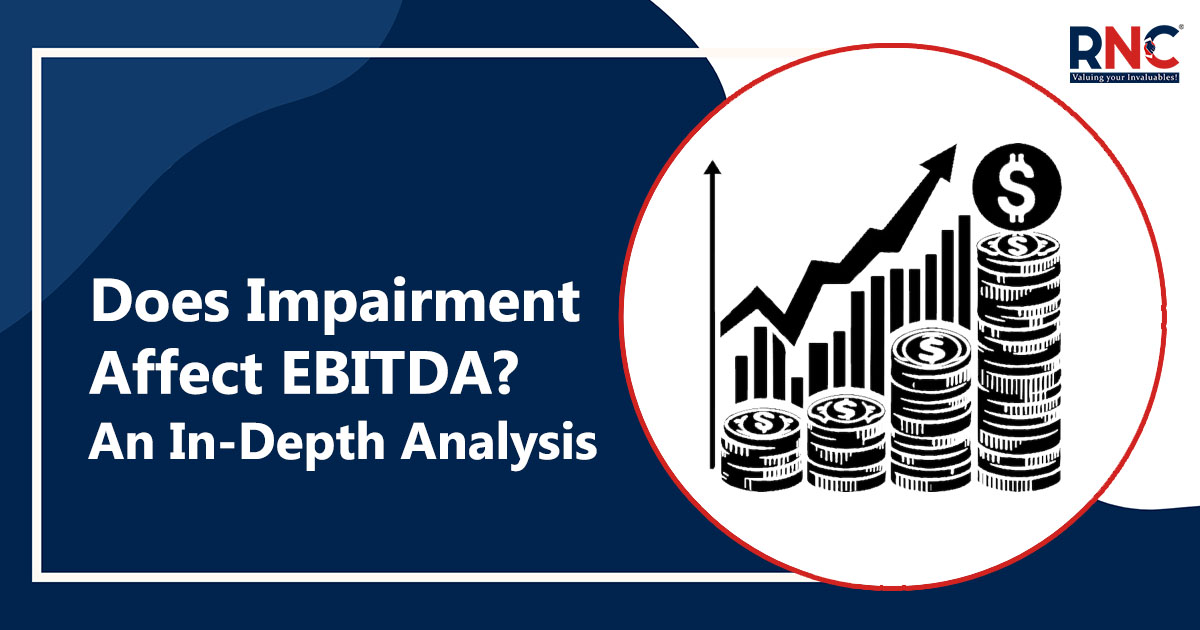
Impairment has become a critical discussion point for businesses, investors, and valuation professionals — especially in 2025, where even a small accounting adjustment can significantly alter key performance metrics like EBITDA (Earnings Before Interest, Taxes, Depreciation, and Amortization).
While EBITDA is widely used to measure a company’s operational profitability, there’s still confusion around how impairment losses influence this figure and whether they should be considered in valuation analysis. Many businesses misinterpret impairment as an operational cost when, in fact, it’s a non-cash accounting entry that affects financial statements differently from core earnings.
In this guide, RNC break down the complete relationship between impairment and EBITDA, explain how these adjustments impact business valuation, and show how to calculate adjusted EBITDA in real-world scenarios. You’ll also learn from 2025-based case examples and expert insights on how valuation professionals interpret impairment while assessing company performance.
What Is Impairment and Why It Matters 2025
In financial reporting, impairment refers to a permanent reduction in the recoverable value of an asset — meaning the asset can no longer generate the same economic benefits it once did. This typically happens due to technological obsolescence, market decline, physical damage, or regulatory changes.
Under Ind AS 36 and IFRS 36, companies must perform impairment testing periodically to ensure that asset values recorded on the balance sheet reflect their true recoverable amounts. When the recoverable amount is less than the carrying amount, the difference is recognized as an impairment loss.
Example:
A manufacturing company owns machinery worth ₹10 crore (book value). After an assessment, the recoverable value is estimated at ₹7 crore.
Impairment loss = ₹10 crore – ₹7 crore = ₹3 crore.
Why It Matters:
| Reason | Impact on Business |
|---|---|
| Reflects true asset value | Prevents inflated balance sheets |
| Improves financial transparency | Builds investor confidence |
| Impacts valuation accuracy | Affects fair value and goodwill |
| Triggers EBITDA adjustments | Impairment may need to be normalized for valuation |
How Impairment Affects EBITDA
One of the most common questions investors ask is — “Does impairment affect EBITDA?”
The short answer is no, not directly — but its indirect effects on valuation and perception can be significant.
EBITDA (Earnings Before Interest, Taxes, Depreciation, and Amortization) measures a company’s operating profitability. Because impairment is a non-cash accounting expense, it is excluded from EBITDA calculations. However, analysts often adjust EBITDA when valuing companies to present a clearer picture of recurring earnings.
Impact of Impairment on Financial Metrics
| Parameter | Before Impairment | After Impairment | Interpretation |
|---|---|---|---|
| EBITDA | Excludes impairment losses | Remains unchanged | No direct effect (non-cash item) |
| Operating Profit (EBIT) | Includes impairment | Decreases | Shows impact on operations |
| Net Profit | Higher | Lower (due to impairment expense) | Reflects overall profitability drop |
| Valuation Multiples (EV/EBITDA) | Based on historical EBITDA | Adjusted for impairment | May need normalization |
Example:
Let’s say a company reports ₹100 crore in EBITDA and records an impairment loss of ₹15 crore on old assets.
-
EBITDA remains ₹100 crore (impairment excluded).
-
EBIT reduces to ₹85 crore, showing lower book profitability.
-
When investors assess valuation, they may add back impairment to get Adjusted EBITDA = ₹115 crore, reflecting true operating performance.
Accounting Standards & Valuation Adjustments 2025
In 2025, both IFRS (International Financial Reporting Standards) and Ind AS (Indian Accounting Standards) continue to play a crucial role in defining how companies recognize and report impairment losses. These frameworks ensure financial transparency and help valuation experts derive a company’s true economic worth.
Key Accounting Guidelines
| Standard | Description | Applicability |
|---|---|---|
| Ind AS 36 – Impairment of Assets | Requires companies to assess whether an asset’s carrying amount exceeds its recoverable amount. | Applicable to all Indian entities following Ind AS. |
| IFRS 36 – Impairment of Assets | Global framework guiding impairment recognition, measurement, and disclosure. | For companies reporting under IFRS. |
| Ind AS 38 / IFRS 38 – Intangible Assets | Defines impairment testing for goodwill, IP, and brand value. | Used in goodwill and business valuation. |
Valuation Adjustments Post-Impairment
When performing business or asset valuation, experts make normalization adjustments to remove the effects of non-recurring items such as impairment.
This process helps analysts arrive at Adjusted EBITDA or Normalized Earnings, which better reflect recurring profitability.
Normalization Process Example:
-
Start with reported EBITDA
-
Add back one-time impairment losses
-
Adjust for any extraordinary income or expenses
-
Calculate Adjusted EBITDA
-
Recompute valuation multiples (EV/EBITDA, P/E, etc.)
Impact on Valuation Metrics
| Metric | Without Adjustment | With Normalization | Result |
|---|---|---|---|
| Reported EBITDA | ₹100 crore | ₹115 crore | +15% improvement |
| EV/EBITDA Multiple | 8x | 6.9x | Improved valuation realism |
| Net Asset Value | Undervalued | Adjusted to true worth | Fair value achieved |
Expert Tip:
“Impairment testing is not a red flag — it’s a recalibration. Analysts who normalize impairment correctly get a more accurate valuation picture.”
— RNC Certified Valuer, Business Advisory Division
Real-World Example of Impairment and Its Impact on EBITDA (2025)
Understanding impairment becomes clearer when we see how it plays out in real companies. Let’s look at a simplified 2025-based case that reflects how impairment influences EBITDA and overall valuation.
Case Example – Technology Manufacturing Company (FY 2024-25)
A listed technology manufacturer had significant R&D assets that became outdated due to rapid AI-driven innovations.
After impairment testing under Ind AS 36, the company recognized a ₹180 crore impairment loss on its intangible assets.
| Metric | Before Impairment | After Impairment | Change |
|---|---|---|---|
| Revenue | ₹2,500 crore | ₹2,500 crore | No change |
| EBITDA | ₹400 crore | ₹400 crore | ❌ No direct impact (non-cash) |
| EBIT | ₹350 crore | ₹170 crore | ↓ ₹180 crore impairment |
| Net Profit | ₹240 crore | ₹60 crore | ↓ ₹180 crore |
| EV/EBITDA | 8× | 8× | Constant |
| EV/EBIT | 9× | 18× | Skewed due to lower EBIT |
Interpretation:
-
EBITDA stays unchanged because impairment is excluded from operating results.
-
EBIT and Net Profit decline sharply, reflecting lower book profitability.
-
For valuation purposes, analysts add back the ₹180 crore impairment to compute Adjusted EBITDA, ensuring fair comparison with previous years.
Valuation Outcome
After normalization, the Adjusted EBITDA increased from ₹400 crore to ₹580 crore, improving valuation consistency and avoiding distortion in EV/EBITDA multiples.
This demonstrates why professional valuers always separate recurring performance from one-time accounting events like impairment.
Key Takeaways
-
Impairment does not reduce EBITDA directly but affects EBIT and perception of profitability.
-
Normalizing impairment improves valuation accuracy.
-
Continuous impairment testing ensures asset values remain realistic under IFRS 36 and Ind AS 36.
How to Adjust EBITDA for Valuation (Step-by-Step 2025 Guide)
When valuing companies in 2025, analysts rarely rely on reported EBITDA. They calculate Adjusted EBITDA, which removes the effects of one-time or non-recurring accounting items such as impairment losses, restructuring costs, or exceptional income. This normalized figure represents the company’s true recurring earning power, forming the base for valuation multiples like EV/EBITDA.
Step-by-Step Process to Calculate Adjusted EBITDA
| Step | Action | Example |
|---|---|---|
| 1. Start with Reported EBITDA | Use the company’s published operating EBITDA. | ₹400 crore |
| 2. Add Back Non-Cash Expenses | Include impairment, asset write-offs, or one-time provisions. | + ₹180 crore impairment |
| 3. Remove Extraordinary Income | Deduct gains not related to core operations (e.g., asset sale). | – ₹20 crore gain |
| 4. Adjust for Normalized Operating Costs | Exclude pandemic-related or restructuring expenses. | + ₹10 crore |
| 5. Arrive at Adjusted EBITDA | Reflects recurring operating profitability. | ✅ ₹570 crore |
Formula
Adjusted EBITDA=Reported EBITDA+Impairment Losses±Other Non-Recurring Items\text{Adjusted EBITDA} = \text{Reported EBITDA} + \text{Impairment Losses} \pm \text{Other Non-Recurring Items}
Example:
If a company reports ₹400 crore EBITDA and ₹180 crore impairment, its Adjusted EBITDA = ₹580 crore (400 + 180).
Analysts then use this normalized value for fair valuation comparisons.
Why Adjusted EBITDA Matters in 2025
-
Removes accounting noise from impairment and other exceptional items.
-
Improves comparability between companies and across years.
-
Enhances investor confidence by showing sustainable earnings.
-
Aligns with global valuation practices under IFRS and Ind AS.
“Normalized EBITDA is the most reliable base for enterprise valuation — impairment adjustments simply restore clarity.”
— RNC Certified Valuer, Financial Advisory Division
Expert Insights & 2025 Valuation Trends
In 2025, global valuation practices have become far more data-driven — integrating AI forecasting, ESG scoring, and predictive accounting models into traditional analysis. Yet, the core principle remains unchanged: valuation accuracy depends on separating operational performance from one-time accounting distortions such as impairment losses.
💬 Expert Insight from RNC Valuers
“Impairment doesn’t weaken a company — it simply corrects its balance sheet.
For a fair valuation, we always normalize EBITDA to exclude one-off impairments and reflect true recurring performance.”
— RNC Certified Valuer, Corporate Finance & Deals Division
Emerging Valuation Trends in 2025
| Trend | Description | Impact on EBITDA Valuation |
|---|---|---|
| AI-Assisted Valuation Models | Machine learning predicts impairment risk & recovery values. | Improves asset forecasting accuracy. |
| ESG-Driven Adjustments | Sustainability performance affects discount rates. | Alters enterprise value calculations. |
| Intangible Asset Revaluation | Brands, IPs, and goodwill tested more frequently. | Leads to higher impairment frequency. |
| Real-Time Financial Dashboards | Continuous monitoring of impairment indicators. | Reduces reporting lag and valuation shocks. |
Conclusion: Impairment and EBITDA — The True Picture in 2025
In 2025, understanding the link between impairment and EBITDA is vital for investors, CFOs, and valuation professionals who want to interpret financial performance accurately. While impairment doesn’t directly reduce EBITDA—since it’s a non-cash accounting item—it can influence valuation perception, investor confidence, and enterprise value when left unadjusted.
The smartest approach is to use Adjusted EBITDA, which eliminates one-time impairments and other extraordinary items, giving a transparent view of recurring profitability. By normalizing impairment, businesses achieve more realistic valuation multiples and build stronger credibility with auditors and stakeholders.
At RNC Valuecon LLP, we combine Ind AS 36 and IFRS 36 compliance with real-world experience to deliver valuations that withstand audit and regulatory scrutiny.
Need expert help in impairment analysis or valuation adjustments?
Book a Consultation with RNC Expert
or explore our related services:
FAQs
Q1. Does impairment reduce EBITDA?
No. Impairment is a non-cash accounting adjustment, so it doesn’t directly affect EBITDA, but it does impact overall valuation.
Q2. Should impairment be added back to EBITDA?
Yes, analysts often add back impairment losses to calculate Adjusted EBITDA for valuation accuracy.
Q3. How does impairment affect valuation multiples?
It may temporarily reduce EV/EBITDA multiples until normalization adjustments are made.
Q4. What is the accounting standard for impairment testing?
Ind AS 36 and IFRS guidelines define how impairment is identified and measured for different asset classes.

About the author:
Sahil Narula
Sahil Narula is the Managing Partner at RNC Valuecon LLP and a Registered Valuer with IBBI. He brings over a decade of experience in Valuation Services, Corporate Finance, and Advisory, having led numerous complex assignments under the Insolvency & Bankruptcy Code, 2016, Mergers & Acquisitions, Insurance, and Financial Reporting.
He is a regular speaker at national forums (ASSOCHAM, CII, ICAI, IBBI, Legal Era) and currently serves as Co-Chairman of ASSOCHAM’s National Council on Insolvency & Valuations and a member of CII’s Task Force on Insolvency & Bankruptcy.
🤝Connect with Sahil on LinkedIn.
